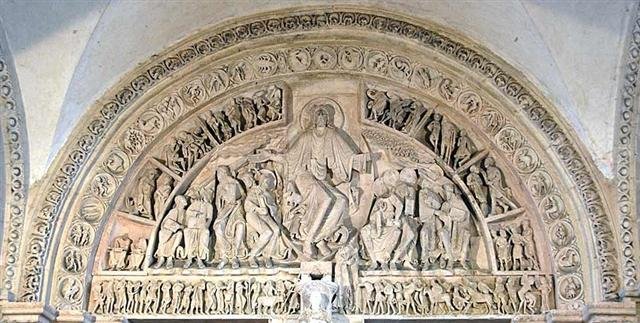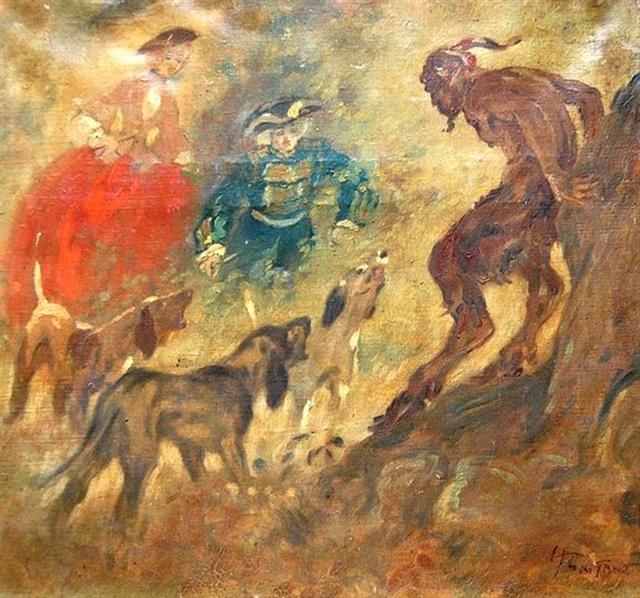There were 4 extra glyphs also at the beginning of side b, but probably they did not correspond to the 4 precessional days from the time of Gregory XIII up to the time of rongorongo. Instead they seem to represent a continuation of the days at the end of side a:
Though in passing we should notice how the Pope had decided to let his new calendar be launched when the Sun reached Thuban, because this was when the Full Moon was at Alrisha, i.e. a Sign of how the old order was ending here with a Knot: ... When Julius Caesar established his calendar in 45 BC he set March 25 as the spring equinox. Since a Julian year (365.25 days) is slightly longer than an actual year the calendar drifted with respect to the equinox, such that the equinox was occurring on about 21 March in AD 300 and by AD 1500 it had reached 11 March. This drift induced Pope Gregory XIII to create a modern Gregorian calendar. The Pope wanted to restore the edicts concerning the date of Easter of the Council of Nicaea of AD 325 ... So the shift in the date of the equinox that occurred between the 4th and the 16th centuries was annulled with the Gregorian calendar, but nothing was done for the first four centuries of the Julian calendar. The days of 29 February of the years AD 100, AD 200, AD 300, and the day created by the irregular application of leap years between the assassination of Caesar and the decree of Augustus re-arranging the calendar in AD 8, remained in effect. This moved the equinox four days earlier than in Caesar's time ... The Julian calendar day Thursday, 4 October 1582 was followed by the first day of the Gregorian calendar, Friday, 15 October 1582 (the cycle of weekdays was not affected) ...
The Head of Ku could represent the end of the previous cycle or the beginning of the next. A door belongs to both. In Roman times 0h was at Al Sheratain. By extending the equinoctial year on side a with 26 precessional days counted from 0h at the time of rongorongo the last glyph on side a would be at glyph 366 + 26 = 392, i.e. when Polaris and Baten Kaitos were at the Full Moon. ... But if the flow is perpetual, it still had a point of 'beginning' and this is found in the Bhagavata Purana (Wilson, p. 138, n. 11): 'The river flowed over the great toe of Vishnu's left foot, which had previously, as he lifted it up, made a fissure in the shell of the mundane egg, and thus gave entrance to the heavenly stream.' How can the Milky Way pour its waters over Polaris? And how can it flow to the four quarters of the earth? Indian diagrams remained fanciful, in the same way as Western medieval ones. It takes some time for one who looks at the great tympanon at Vézelay to realize there is a space-time diagram, as it were, of world history centered on the figure of Christ. The effect is all the greater for the transpositions.
It was not wholly absurd, either, for archaic cosmology to have double locations, one, for instance, on the ecliptic and one circumpolar. If Tezcatlipoca drilled fire at the pole to 'kindle new stars', if the Chinese Saturn had his seat there too, so could Vishnu's toe have bilocation: one 'above' in the third region, the other in beta Orionis-Rigel (the Arabian word for 'foot'), the 'source' of Eridanus. (And might not Rigel-the-source stand also for Oervandil's Toe, catasterized by Thor?) For Rigel marked the way to Hades in the tradition of the Maori of New Zealand as well as in the Book of Hermes Trismegistos ... A line had thus been drawn, in the text on side a of the C tablet, all the way up from from Acrux to Polaris, from the beginning of side a to its end. Although 4 extra days had first to be added because of the flow of time from the Pope Gregory XIII to the time of rongorongo. The first line on Hawaii was drawn from Polaris to Acrux, but that was on the other side of the equator where the opposite order ruled. ... The first line is drawn from Hoku-paa, the fixed or North Star, to the most southerly star of Newe, the Southern Cross ... The portion (of the sky) to the right or east of this line (the observer is evidently assumed to be facing north) is called ke ala ula a Kane, the dawning or bright road of Kane, and that to the left or west is called ke alanui maawe ula a Kanaloa, the much-traveled highway of Kanaloa ... East is east both in the north and in the south, and we can guess side a on the C tablet should be regarded as its left (female, liquid) side and side b as its male (right) side, i.e. belonging to Tane. Indeed we can imagine him (the Tree, rakau) breaking through in Cb1-6:
Tagaroa was earlier than Tane, we know from myth - it was his red and yellow feathers which fell down from the sky to become trees. ... Ta'aroa sat in his heaven above the earth and conjured forth gods with his words. When he shook off his red and yellow feathers they drifted down and became trees. He created the first parents, Tumu-nui, Great Foundation, to be the husband, and Paparaharaha, Stratum Rock, to be the wife. He put the very essence of himself into their creation; yet when he commanded them to wed, each refused to go to the other. So Ta'aroa created other gods and Atea, Bright Expanse, the Sky-goddess, who dwelt in darkness in the confined sky Rumia. By Papa-tuoi, Thin Earth, Atea was the mother of children who became artisans for Rai-tupua-nui, Great-Sky-builder. They assisted him in erecting the ten heavens above the earth. In the highest of these dwelt the god Tane, so it was called the Sky-of-the-sacred-omens of Tane and Sky-of-the-water-of-life of Tane. The next highest heaven was called Hiro's Sky-of-prophets. Atea then became the wife of Rua-tupua-nui, Source of Great Growth, and they became the parents of all the celestial beings, first the shooting stars, then the Moon and the Sun, next the comets, then the multitude of stars and constellations, and finally the bright and dark nebulae. When this tremendous task had been accomplished Atea took a third husband, Fa'a-hotu, Make Fruitful. Then occurred a curious event. Whether Atea had wearied of bringing forth offspring we are not told, but certain it is that Atea and her husband Fa'a-hotu exchanged sexes. Then the [male] eyes of Atea glanced down at those of his wife Hotu and they begat Ru. It was this Ru who explored the whole earth and divided it into north, south, east, and west ... *215 (Arcturus) - *189 (Avis Satyra) = *26 = *392 - *366.
|
|||||||||||||||||||||||||||||||||||||||||||||||||||||||||||||||||||||||||||||||||||||||||||||||||||||||||||||||||||||||||||||||||||||||||||||||||||||||||||||||||||||||||||||||||||||||||||||||||||||||||||||||||||||||||||||||||||||||||||||||||||













